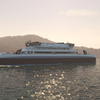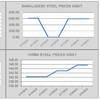Downside of Shipping Boom: Capacity Constraints and Increased Risks
The maritime industry is in the midst of a historic boom that vessel owners can barely keep up with. And while that may be good for their wallets, the issues that go along with the rapid growth in cargo shipments are causing enough uncertainties to give them sleepless nights.
Marine insurers are in a good position to understand the challenges that face the maritime industry — after all, what insurers do for a living is deal with uncertainty on behalf of our customers. There is no denying, however, that many of the same issues that are facing vessel owners and shippers make our jobs more difficult in terms of analyzing, managing and covering risk.
By partnering together, shippers, vessel owners and insurers can weather the turbulent times, as they have since the earliest days of moving goods by sea. Their mutual goal? To understand the issues that arise from capacity constraints, and to address potential problems before they become ocean marine losses.
Keeping Up with Demand
In earlier columns, I have addressed many of the stress points that the maritime industry faces today. Bringing them together in one spot simply emphasizes how much pressure ship operators and exporters are under. The issues include:
• Vessel construction backlog. An unprecedented number of ships are under construction. A recent Reuter's story indicates that current orders for 1,100 ships with a value of $350 billion have caused a three-year backlog at shipyards. The backlog not only means long waits for ship owners who want to add to their fleet now, but also raises concerns about quality amid the frantic construction pace that shipyards are attempting.
• Inexperienced crews. As ship owners add capacity, they are finding it increasingly difficult to man their new vessels with well-trained people. Skilled labor is at a premium in many industries in America at a time when fewer young people are entering trade jobs. In addition, the old approach of growing seasoned sailors from novice deckhands is slow and difficult with the new complexity of modern ships. Marine institutes so far have failed to grow their programs fast enough to produce the needed workers.
• Aging vessels. Ships that normally would be retiring after a long and useful life are now being kept in service past their best years to meet the demand for more capacity. In addition, some tanker owners are converting their vessels to bulk carriers to avoid the costly requirements of double hulling. In both cases, owners are betting that ships will perform well, even though design criteria may indicate a more cautious approach may be warranted.
• Larger capacity. Containerization has changed not just the face of shipping, but also its size. A decade ago, a ship might haul 2,000 containers; today, it is likely to be carrying 6,500 containers - each with an average value of $100,000. The plus is being able to move more goods from one place to another in a single shipment. But the negative is that when something goes wrong, the value of the cargo loss is far greater.
• Terminal infrastructure. With increasing amounts of cargo arriving on their doorsteps in ever-larger ships, ports are under pressure to both load and offload shipments quickly and damage-free. Yet much of the terminal infrastructure in place was built for earlier times, when the amount of cargo passing through was much less. Ports are one more area where risks have increased because of the pressure that growth places on how work is performed.
• Container shortage. As exports have surged, shippers have found it increasingly difficult to locate containers in the United States that can be used to send their goods overseas. That means sometimes settling for containers that may be damaged or in uncertain condition, leaving cargo less protected than is desirable.
• Commodity prices. Rapidly rising commodity prices mean that raw goods being shipped are worth more than in the past - in fact in some cases, such as oil, steel and corn, prices are at historical highs. Potential losses, therefore, are much greater. There are other implications as well. The price of the steel that it takes to build ships has skyrocketed in the face of demand from growing economies in China and India, making capacity investments far more costly for ship owners. And rising prices have made raw commodities far more attractive targets for thieves. One example: A ship recently hijacked off the coast of Somalia was carrying $85 million worth of zinc, a "treasure" that few pirates would have cared about before the surge in commodity prices.
• Unfamiliar routes. U.S. exports are growing at double-digit rates and trade patterns are shifting as new economies expand in other parts of the world, creating global demand that our industries are rushing to meet. Where once Canada and Europe were our major trading partners, today raw materials and goods may be destined for China, India, Africa and Latin America. New business partners offer exciting opportunities, but they can also mean different trading routes with unknown risks and unfamiliar ports with different levels of sophistication and equipment.
Coping with Risk
Each of the factors above adds to the risk that vessel owners and exporters face. And there is little sign that the pressure from the growth in global trade will ease any time soon. Economies in China and India continue to expand annually at double-digit rates, with rapid modernization and huge population bases driving the thirst for consumer goods. Emerging economies in Eastern Europe add to demand. At one time a faltering U.S. economy might have slowed growth in the rest of the world; but today, the global economy continues to expand despite a U.S. slowdown.
In the short term, coping with increased risk means paying attention to detail and taking appropriate precautions. Vessel owners and exporters will benefit from working closely with marine insurers that have both the seasoned expertise to assess the impact of these expanded risks and the financial strength to provide necessary coverage. The best marine insurers have the resources and insight to help their customers identify and implement risk reduction strategies.
As with any expanding marketplace, the long term answer lies in increased investment in a combination of people, technology and equipment. Training programs that will enlarge the pool of capable workers, improvements to terminal infrastructure that will make cargo transfer more efficient, and new capacity that will provide the ships and containers exporters are looking for - all of these steps are already under way to equip the marine industry to meet the challenges of a sustained period of vibrant growth.
(Reprinted from the September edition of Maritime Reporter)










